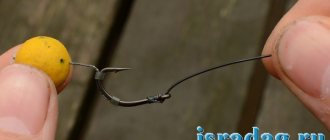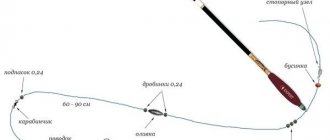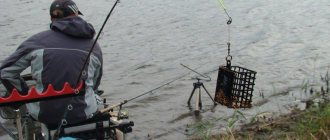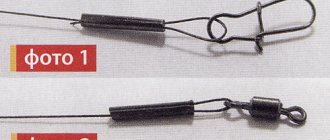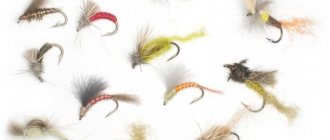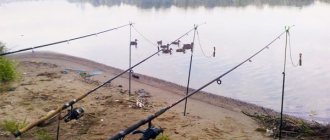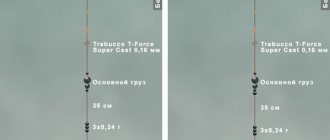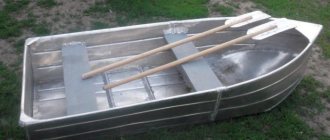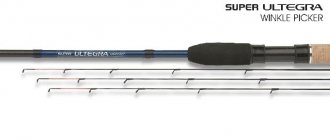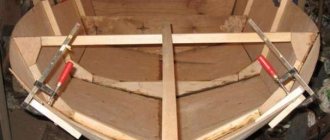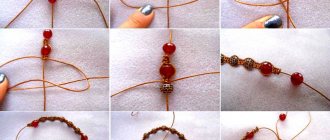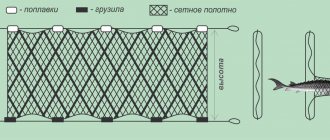Why do you need a leash when fishing for pike?
The leash is a cord with loops at both ends, firmly connected to the main body of the leash by means of a crimp tube. At one end, as a rule, a carabiner is attached, at the other - a swivel for free rotation of the bait.
Used when fishing for pike to avoid biting the main line.
Do you need a leash when fishing for pike?
If, when fishing for pike perch or asp, fishermen’s opinions about the need for a leash differ, then when fishing for pike, anglers are unanimous. Fishing for “toothy” without a leash will be akin to a lottery: if you’re lucky or unlucky. In addition, if we take into account that pike baits are not cheap, then such a lottery will not be justified.
Even if a spotted predator is not the object of your hunt and you are hoping to fish for perch or catch pike perch, it is better to play it safe and take a couple of leashes with you. Pike is an omnivorous predator and may well covet perch or any other bait.
So, if your financial situation does not allow you to lose 8-10 expensive wobblers on each fishing trip, then you simply need a leash.
Is a pike afraid of a leash?
It is difficult to argue with the fact that the strongest leashes, capable of withstanding the teeth of large individuals, are clearly visible even in muddy water. But pike fishing is usually fast and aggressive, and the baits are often quite massive. So with a lightning strike, the fish is on the tee before it has time to see the piece of wire.
If you still have doubts, try more transparent and inconspicuous options for fishing, such as a fluorocarbon leash. Be prepared for the fact that its durability is lower than others.
Material from which leashes are made
The presented classification of leader material will help influence the quality of bites. The advantages and disadvantages of various types of this part of the equipment will be discussed further.
Rating of leashes by price (from expensive to cheap leashes):
- Titanium leashes
- Tungsten
- Steel (strings)
- Braided steel
- Fluorocarbon
- Nylon
6.1 Fluorocarbon leaders
The combination of fluorine and carbon allows one to obtain a substance such as fluorocarbon. The technical side of fluorocarbon production is identical to the production of nylon monofilament lines.
Leaders made of this material are recommended for use in cases where camouflage of the fishing line in the water plays an important role, for example, when catching cautious fish. Fluorocarbon is valued for its transparency in water, however, not 100%.
The downside to using fluorocarbon wire is that the larger the diameter, the more noticeable it is in the water. Thus, a leash diameter greater than 0.35 mm already loses its “invisible” properties.
Positive properties:
- invisibility in water due to the low level of light refraction in water;
- wear resistance, does not stretch, which allows for sharp and powerful hooking of fish;
- speed of immersion in water;
- the ability to withstand changes in temperature conditions, which does not affect the loss of its original characteristics;
- does not absorb water, which allows it to retain its shape for a long time.
What kind of gear is a fluorocarbon leash attached to:
- spinning rod (lead length from 1 to 3 m);
- float rod (lead length from 15 to 30 cm);
- feeder (used less often, since the equipment lies on the bottom when casting, but with some equipment options, a leash can be attached and then the equipment will hang in the water column above the bottom).
The diameter of the leader depending on the weight of the fish:
- from 1.3 kg – not less than 0.14 mm;
- from 1.8 kg – 0.16 mm;
- from 4 kg – 0.2 mm;
- from 6 kg - 0.31 mm.
An interesting video about this type of leash from the “Hunter and Fisherman” channel
6.2 Leaders made of leader material
Leashes made from leash material are homemade. This material is purchased in a store and consists of many thin steel rods, which are woven together into one thread and covered with a special film. Then leashes are made from it.
Area of application : fishing with spinners and wobblers in areas overgrown with vegetation. For example, Russian fishermen use this material to make leashes for pike fishing. Under such fishing conditions, fluorocarbon leashes should not be used due to their high cost and the high probability of being eaten by a predator.
Fishing methods:
- jig;
- mugs.
Advantages of this material:
- softness, which has a positive effect on the performance of light-weight baits;
- low memory, which eliminates severe deformation of the leash over time.
Flaws:
- wears out, which manifests itself in the form of detachment of threads of material from the common braid, in which case the leash needs to be replaced;
- with strong knots it becomes deformed.
Instructions for making a leash from leash material are described in detail here https://makchen.ru/nadezhnye-povodki-dlya-rybalki-svoimi-rukami-iz-povodkovogo-materiala-pontoon-21.html
Interesting to see! A little trick for squeezing a leash at home from the author of the video 100500 obzorov
6.3 Steel leads
Advantages of a steel leash:
- rigidity (impossibility of snacking on fish);
- does not get confused;
- passes through algae perfectly and cuts them with a sharp jerk;
- attractive price.

Flaws:
- cumbersome equipment;
- poor camouflage in water;
- nodes are the weakest point;
- plastic.
Application area:
- jig fishing;
- twitching;
- fishing with wobblers.
Where to buy:
- fishing shops;
- make it yourself from pieces of field wire (other names: field wire, military field cable) or guitar string (the largest in diameter).
One example of making a leash from bentgrass, proposed by the author-fisherman Corleone
Advantages of a field cable leash:
- ease;
- small diameter;
- cheap;
- excellent for fishing with small wobblers (does not affect their behavior in water).

Advice: when using wobblers, to prevent their loss, it is better to attach such a leash to the factory ring of the bait.
Flaws:
- poor flexibility and not long (no more than 15 cm), if you do more, the leash will begin to curl;
- When fishing for large fish, the loop of such a leash becomes very tight.
- does not have an even shape, you need to manually align it;
- production time costs.
6.4 Titanium leads
Titanium leashes are one of the most modern elements of spinning equipment on the fishing market and differ from the rest in their high cost.
Externally very similar to leashes made of leash material.
Advantages:
- durability;
- zero memory;
- resistance to snacking;
- It is made of lightweight material, which allows the wobbler to show all its playing properties in the water. For example, metal leashes can make any surface wobbler suspended or sinking due to the heavy weight of the equipment;
- do not require special care, as they are not subject to oxidation.
Flaws:
- rude;
- noticeable in the water;
- subject to rupture, for example, when caught on snags;
- the high cost of the leash and accessories for it.
Twenty-minute video from V. Kolomiets, offering one of the methods for making a leash from titanium material
6.5 Tungsten leaders
The leash is made by twisting threads of tungsten material.
Tungsten is the most refractory metal. In the USA, France and England, such material is usually called “tungsten” or in Russian heavy stone.
Advantages:
- inexpensive;
- soft, which has a good effect on the game of the bait;
- reliable.
Tip: to extend the life of the leash and straighten it, just hold the bend over the fire (for example, using a lighter). However, it is worth remembering that when using this method of resuscitation, the leash at the warming site becomes brittle.
Flaws:
- short-lived (when used more than three times, it tends to twist strongly, which makes it completely unusable for further use);
- quickly wears out in the place where the fastener is attached, which may be a consequence of losing the wobbler.
6.6 Guitar string leads
To make a leash at home, you need to twist two guitar strings (1 and 2) together.
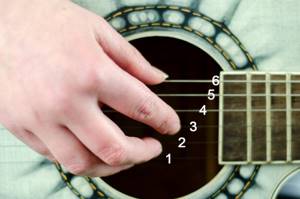
Advantage:
- no need to use additional fittings, since loops are made at the ends of the future leash;
- strength;
- rigidity.
Flaws:
- poor flexibility, which ultimately has a bad effect on the performance of the bait;
- inconvenience when attaching or removing the bait (you need to unwind the loops);
- are susceptible to corrosion, even in freshwater, so use in sea fishing is not advisable.
Pike leash length and diameter
Many fishermen make the mistake of playing it safe and using a leash that is too long. Before casting, the bait is inevitably positioned too far from the “tulip”. As a result, a “pendulum” that is too long is formed, making it impossible to make an accurate and long cast. The shorter the leader, the easier it is to cast the artificial bait.
What is the optimal leash length for pike, size
It is not recommended to use leashes longer than 30 cm. The best option: 15-25 cm.
As for the diameter, if we consider a steel or titanium product, then a thickness of 0.7-0.8 mm is enough to support a trophy weighing 50 kg. If the choice fell on less durable materials, then you should choose a thicker leash.
Video: How to choose the right leash?
Fishing with a leash significantly increases the chances of catching a pike, and the right choice of material guarantees a good bite. Each angler chooses the manufacturer and material for leashes to suit his taste and situation. Some anglers prefer to make their own equipment for pike fishing. One way or another, among experienced fishing enthusiasts there are hardly anyone who would not agree that it is better to “keep” the pike on a strong leash. Happy fishing!
Views: 1,625
Similar articles:
- Homemade steel leashes. Choosing a leader material for pike fishing The simplest leader material for pike is wire: nichrome, guitar...
- Fluorocarbon leashes for pike Pike fishing is a very exciting and popular type of fishing. At…
- Fishing mugs for pike: design, equipment, methods of fishing on lakes and rivers Everything about fishing for pike with mugs. Structurally, the fishing circle…
- Storage of spinning rods, reels and leashes Sports fishing tackle designed for catching predatory fish has a special…
Fluorocarbon
Fluorocarbon material is resistant when placed in an aggressive environment. This chemical polymer has found application in fishing due to its invisibility in the water. The fishing line made of fluorocarbon does not change its characteristics under the influence of the temperature field.
The fishing line does not stretch or fray, and quickly sinks in water. Considering its high cost, it is used only as a leash, and a regular fishing line is attached to it. The material has a complex production technology, which results in its high cost. A leash made of fluorocarbon fishing line can withstand up to twenty bites, so you should constantly monitor it during the fishing process. There are technologies for coating conventional fishing line with fluorocarbonate coating.
